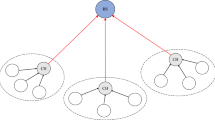Abstract
Social-based sensor networks are prone to congestion due to the limited storage space on each node and the unpredictable end-to-end delay. In this paper, we aim to develop an efficient congestion control approach from the social network perspective. For this purpose, we first identify the role of social ties in the process of congestion and specify a list of major congestion factors. Based on these factors, we then model the congestion control as a multiple attribute decision making problem (MADM), in which the weight of congestion factors is measured by an entropy method. We present a MADM-based congestion control approach that determines a set of forwarding messages and its transmission order on each encounter event. Moreover, we design a buffer management scheme that deletes messages whose removal would incur the least impact upon the network performance when the buffer overflows. Extensive real-trace driven simulation is conducted and the experimental results finally validate the efficiency of our proposed congestion control approach.





Similar content being viewed by others
References
Huangfu W, Zhang Z, Chai X, Long K (2014) Survivability-oriented optimal node density for randomly deployed wireless sensor networks. Science china information sciences 57(2):1–6
Dong M, Ota K, Yang LT, Chang S, Zhu H, Zhou Z (2014) Mobile agent-based energy-aware and user-centric data collection in wireless sensor networks. Comput Netw 74:58–70
Wei K, Liang X, Xu K (2014) A survey of social-aware routing protocols in delay tolerant networks: Applications, taxonomy and design-related issues. IEEE Commun Surv Tutorials 16(1):556–578
Dong M, Ota K, Li H, Du S, Zhu H, Guo S (2014) RENDEZVOUS:towards fast event detecting in wireless sensor and actor networks. Computing 96(10):995–1010
Wan CY, Eisenman SB, Campbell AT (2003) Coda: Congestion detection and avoidance in sensor networks in SenSys, pp. 266–279
Tao LQ, Yu FQ (2010) Ecoda: enhanced congestion detection and avoidance for multiple class of traffic in sensor networks. IEEE Trans Consum Electron 56(3):1387– 1394
Kumar R, Crepaldi R, Rowaihy H, III AFH, Cao G, Zorzi M, Porta TFL (2008) Mitigating performance degradation in congested sensor networks. IEEE Trans Mob Comput 7(6):682– 697
Ren F, He T, Das S, Lin C (2011) Traffic-aware dynamic routing to alleviate congestion in wireless sensor networks. IEEE Trans Parallel Distrib Syst 22(9):1585-1599
Wei K, Guo S, Xu K (2014) CACC: A context-aware congestion control approach in smartphone networks. IEEE Commun Mag 52(6):42
Cao Y, Xu C, Guan J, Zhang H (2014) Qos-driven sctp-based multimedia delivery over heterogeneous wireless networks. Science China Information Sciences 57(10):1
Dong M, Ota K, Lin M, Tang Z, Du S, Zhu H (2014) UAV-assisted data gathering in wireless sensor networks. J Supercomput 70(3):1142
Wei K, Guo S, Zeng D, Xu K (2014) A multi-attribute decision making approach to congestion control in delay tolerant networks. In: Proceedings of IEEE International Conference on Communications , pp. 2742–2747
Zhang N, Ding N, Hu X (2014) Congestion control based on multi-priority data for opportunistic routing. Advances in wireless sensor networks 418:122–132
Silva A P d, Burleigh S, Hirata CM, Obraczka K (2014) Congestion control in disruption-tolerant networks: a comparative study for interplanetary networking applications. In: Proceedings of the 9th ACM MobiCom Workshop on Challenged Networks, pp. 65–68
Lo S, Luo Y (2014) Transfer reliability and congestion control strategies in opportunistic networks: A survey. IEEE Commun Surv Tutorials 16(1):538
Akestoridis DG, Papanikos N, Papapetrou E (2014) Exploiting social preferences for congestion control in opportunistic networks. In: IEEE International Conference on Wireless and Mobile Computing, Networking and Communications, pp. 413–418
Yang JB, Singh Madan G (1994) An evidential reasoning approach for multiple-attribute decision making with uncertainty. IEEE Trans Syst Man Cybern 24(1):1-18
Shannon CE (2001) A mathematical theory of communication. SIGMOBILE Mobile Computing and Communications Review 5(1):3-55
Keränen A, Ott J, Kärkkäinen T (2009) The ONE simulator for DTN protocol evaluation. In: SIMUTools
Scott J, Gass R, Crowcroft J, Hui P, Diot C, Chaintreau A (2009) Data Set Cambridge/haggle/imote/infocom2006. Downloaded from http://crawdad.cs.dartmouth.edu/infocom2006
Bigwood G, Rehunathan D, Bateman M, Henderson T, Bhatti S (2011) data set st andrews/sassy, http://crawdad.cs.dartmouth.edu/standrews/sassy
Meroni P, Gaito S, Pagani E, Rossi GP (2008) Data Set Unimi/Pmtr, http://crawdad.cs.dartmouth.edu/unimi/pmtr
Vahdat A, Becker D Epidemic Routing for Partially-connected Ad Hoc Networks,Duke University, Tech. Rep
Spyropoulos T, Psounis K, Raghavendra C (2008) Efficient routing in intermittently connected mobile networks: The multiple-copy case. IEEE/ACM Trans Networking 16(1):77–90
Lindgren A, Doria A, Schelén O, Mob S I G M O B I L E (2003) Probabilistic routing in intermittently connected networks. Comput Commun Rev 7(3):19–20
Acknowledgments
We first thank anonymous reviewers for their patient review and valuable comments, which significantly improve the quality of this paper. Our work was supported by National Natural Science Foundation of China (Grant No. 61421003 and 61373125 and 61402425) and the fund of the State Key Lab of Software Development Environment (Grant No. SKLSDE-2015ZX-05) and Science and Technology Planning Project of Guangdong Province, China (Grant No. 2013B010401016).
Author information
Authors and Affiliations
Corresponding author
Rights and permissions
About this article
Cite this article
Wei, K., Guo, S., Li, X. et al. Congestion control in social-based sensor networks: A social network perspective. Peer-to-Peer Netw. Appl. 9, 681–691 (2016). https://doi.org/10.1007/s12083-015-0352-0
Received:
Accepted:
Published:
Issue Date:
DOI: https://doi.org/10.1007/s12083-015-0352-0




